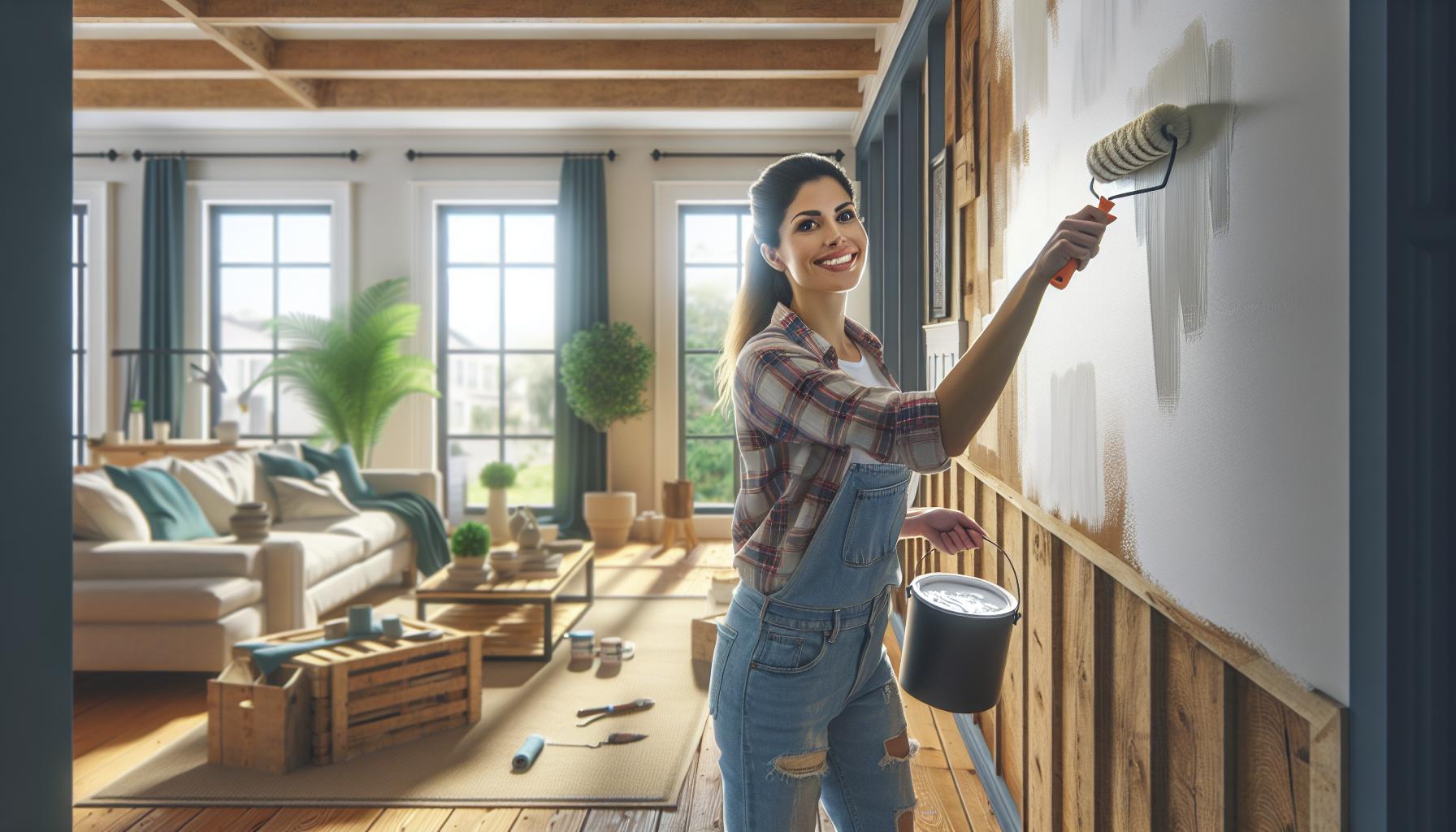INTRODUCTION:
Embarking on a home renovation? Imagine sprucing up a space while giving the planet a high-five. Sustainable home renovation isn’t just a trend—it’s a smarter greener way to transform living environments.
From energy-efficient appliances to repurposed materials, making eco-friendly choices can save money and reduce carbon footprints. Plus, who wouldn’t want a home that’s stylish and kind to the Earth? Dive into the world of sustainable renovations and discover how beautiful resilient homes that stand the test of time can be created.
Benefits of Sustainable Home Renovation
Sustainable home renovation enhances energy efficiency, lowering utility bills significantly. Homeowners often see a reduction of up to 30% in their energy costs after upgrading to energy-efficient windows and insulation. Additionally, using renewable materials like bamboo flooring or recycled steel decreases the environmental impact by minimizing resource depletion.
Improved indoor air quality is another key advantage. Eco-friendly paints and non-toxic materials reduce harmful emissions, creating a healthier living environment. This change is especially beneficial for families with children or individuals with respiratory issues.
Moreover, sustainable renovations increase property value. Homes with green features attract buyers willing to pay a premium, often resulting in faster sales. Investing in solar panels or energy-efficient appliances not only lowers operational costs but also makes the property more appealing in the competitive real estate market.
Furthermore, these renovations contribute to long-term durability. Materials chosen for sustainability, such as reclaimed wood or high-grade insulation, offer greater resilience against wear and tear. This resilience reduces maintenance costs and extends the lifespan of home components.
Lastly, engaging in sustainable home renovation supports environmental conservation. By reducing carbon footprints and conserving natural resources, homeowners play a vital role in combating climate change. Communities benefit collectively as widespread adoption of green practices leads to significant environmental improvements.
| Benefit | Description |
|---|---|
| Energy Efficiency | Lowers utility bills by up to 30% with upgrades like energy-efficient windows and insulation. |
| Improved Indoor Air Quality | Reduces harmful emissions through eco-friendly paints and non-toxic materials. |
| Increased Property Value | Attracts buyers willing to pay a premium for green features, leading to faster sales. |
| Long-term Durability | Utilizes resilient materials like reclaimed wood, reducing maintenance costs. |
| Environmental Conservation | Decreases carbon footprints and conserves natural resources, aiding climate change efforts. |
By prioritizing these benefits, homeowners achieve both economic savings and contribute positively to environmental sustainability.
Key Principles of Sustainable Renovation

Sustainable renovation focuses on minimizing environmental impact while enhancing home functionality. Implementing key principles ensures long-term benefits for both homeowners and the planet.
Eco-Friendly Materials
Choosing eco-friendly materials reduces a home’s carbon footprint and promotes resource conservation. Reclaimed wood repurposes existing resources, decreasing the need for new lumber. Recycled metal offers durability and lowers mining impacts. Low-VOC paints improve indoor air quality by minimizing harmful emissions. Bamboo flooring provides a renewable alternative to traditional hardwoods, growing faster and requiring fewer chemicals. Additionally, insulated concrete forms enhance energy efficiency while maintaining structural integrity. These materials not only support environmental sustainability but also increase property value and appeal to eco-conscious buyers.
Energy Efficiency
Enhancing energy efficiency significantly lowers utility costs and reduces environmental impact. Installing energy-efficient windows decreases heat loss, contributing to lower heating bills by up to 30%. Upgraded insulation maintains optimal indoor temperatures, minimizing the need for excessive heating and cooling. Energy Star-rated appliances consume less electricity, resulting in cost savings and decreased energy demand. High-efficiency HVAC systems provide consistent climate control with reduced energy usage. Implementing smart thermostats allows precise temperature management, further optimizing energy consumption. These measures collectively enhance a home’s sustainability, offering financial savings and supporting broader climate change mitigation efforts.
Sustainable Materials and Technologies
Sustainable home renovations incorporate materials and technologies that minimize environmental impact while enhancing functionality and efficiency.
Recycled Materials
Utilizing recycled materials reduces waste and conserves natural resources. Reclaimed wood repurposes old structures, providing unique aesthetics and durability. Recycled metal offers strength for structural elements and decorative features, lowering the demand for new metal production. Additionally, recycled glass can be used in countertops and tiles, adding a stylish touch to kitchens and bathrooms. Incorporating these materials not only decreases the carbon footprint but also often results in cost savings. For example, choosing recycled insulation materials can enhance energy efficiency, leading to lower utility bills. By prioritizing recycled materials, homeowners contribute to environmental conservation and create unique, resilient spaces.
Smart Home Technologies
Integrating smart home technologies boosts energy efficiency and enhances living comfort. Smart thermostats automatically adjust temperatures based on occupancy, optimizing heating and cooling systems. Energy-efficient lighting systems, such as LED smart bulbs, reduce electricity consumption while providing customizable lighting options. Advanced home automation systems manage appliances and electronics, ensuring they operate only when needed, which lowers energy usage. Additionally, smart water management systems monitor usage and detect leaks, preventing water waste. These technologies not only reduce utility costs but also support sustainable living by minimizing resource consumption. By adopting smart home solutions, homeowners achieve greater control over their energy use and contribute to a more sustainable household.
Energy Efficiency Improvements
Enhancing energy efficiency is essential in sustainable home renovation. These upgrades reduce utility costs and minimize environmental impact.
Insulation and Sealing
Effective insulation and sealing boost a home’s thermal performance. High-quality materials like spray foam, cellulose, or fiberglass maintain consistent indoor temperatures year-round. Sealing gaps around windows, doors, and ducts prevents air leakage, optimizing energy use. Installing insulated windows and doors decreases heat transfer, contributing to significant energy savings. Installing radiant heat under subfloor can improve overall warmth and comfort without increasing energy consumption. Homeowners can achieve up to 30% reduction in heating and cooling expenses, fostering a comfortable and sustainable living environment.
Renewable Energy Sources
Integrating renewable energy sources elevates a home’s sustainability profile. Solar panels generate clean electricity, lowering reliance on fossil fuels and reducing energy bills. Wind turbines offer an alternative for regions with steady wind patterns, providing consistent power generation. Geothermal systems utilize the earth’s stable temperatures to efficiently regulate indoor climates. These installations not only cut energy costs but also increase property value. Additionally, available incentives and tax credits make adopting renewable energy more accessible, supporting homeowners in their sustainability efforts.
Cost Considerations and Savings
Sustainable home renovations involve various financial aspects. Balancing initial expenses with long-term benefits proves essential.
Initial Investment vs Long-term Savings
Upfront costs for sustainable renovations, such as energy-efficient windows, high-quality insulation, and renewable energy systems, exceed traditional alternatives. These investments yield substantial long-term savings by lowering utility bills. Energy-efficient appliances reduce electricity consumption, potentially decreasing monthly expenses by up to 30%. Solar panels generate renewable energy, cutting reliance on grid power and providing ongoing savings. Durable materials minimize maintenance and replacement costs, enhancing financial benefits over time. Additionally, improved home energy performance increases property value, offering a higher return on investment. Homeowners often recoup initial expenses within several years through these continuous savings, demonstrating the financial viability of sustainable renovations.
Incentives and Rebates
Government incentives and rebates significantly offset the costs of sustainable renovations. Federal and state programs offer tax credits for installing energy-efficient systems like solar panels and heat pumps. Utility companies provide rebates for upgrading to Energy Star appliances and enhancing home insulation. Local governments may grant grants or low-interest loans for green home projects, reducing the overall investment required. For instance, the federal Investment Tax Credit (ITC) returns a percentage of solar panel installation costs to homeowners. Manufacturer rebate programs lower the upfront costs of eco-friendly products, making sustainable options more accessible. Utilizing these financial incentives enhances the affordability of sustainable home improvements and accelerates the return on investment.
Finding the Right Professionals
Selecting the right professionals ensures sustainable practices are effectively integrated into your home renovation. Qualified experts bring expertise and reliability to your green project.
Certified Contractors
Certified contractors specialize in sustainable building practices and hold credentials like LEED or ENERGY STAR. They ensure compliance with environmental standards and utilize eco-friendly materials such as recycled steel and low-VOC paints. These contractors implement energy-efficient installations, including solar panels and high-performance insulation, which can reduce utility bills by up to 30%. Additionally, certified professionals stay updated on the latest green technologies and regulations, ensuring your renovation meets current sustainability criteria. Verifying certifications and reviewing previous projects helps confirm a contractor’s proficiency in sustainable renovations. Hiring certified contractors guarantees high-quality workmanship and adherence to environmental goals, making your renovation both eco-friendly and cost-effective.
Sustainable Design Experts
Sustainable design experts create environmentally responsible and resource-efficient home layouts. They focus on maximizing natural light and optimizing energy usage through smart design choices. These specialists select materials like reclaimed wood, bamboo flooring, and recycled glass countertops to minimize environmental impact. Incorporating renewable energy solutions, such as solar panels and geothermal heating, enhances your home’s energy efficiency and reduces carbon footprints. Sustainable design professionals also prioritize water conservation by integrating fixtures like low-flow toilets and rainwater harvesting systems. Collaborating with these experts ensures your renovation aligns with green principles, enhancing both functionality and sustainability. Assess their portfolios and seek client testimonials to ensure their design approach meets your eco-friendly renovation objectives.
Conclusion
Embracing sustainable home renovation transforms living spaces into eco-friendly sanctuaries that benefit both homeowners and the planet. By integrating energy-efficient solutions and recycled materials, homes become more resilient and cost-effective. This mindful approach not only reduces environmental impact but also enhances property value and appeal. As awareness grows, more individuals are choosing to invest in sustainable practices, paving the way for a greener future. Sustainable renovations represent a smart and responsible choice, ensuring homes remain comfortable and efficient for years to come.

